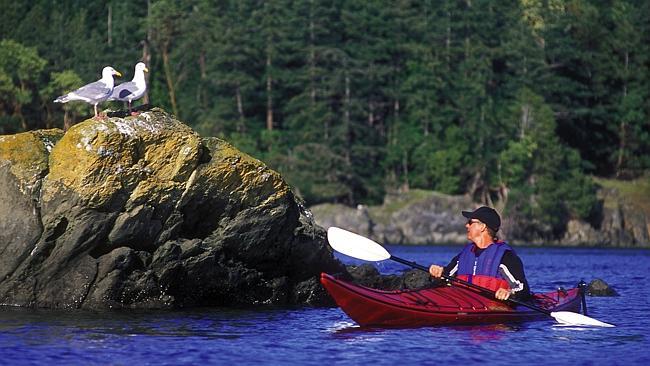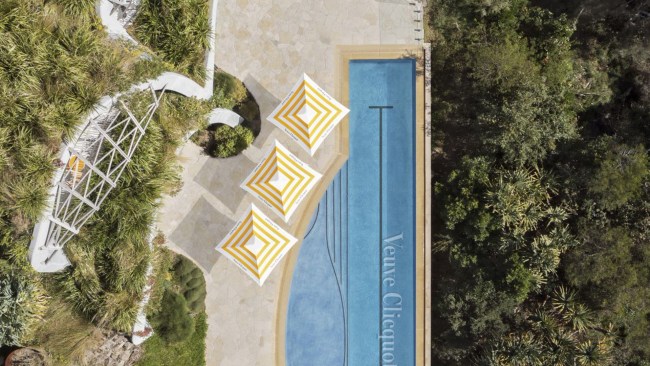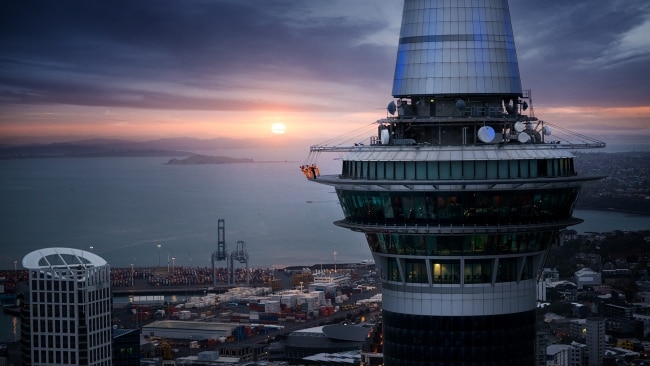Kayaking on Vancouver’s Sunshine Coast
PADDLE with a purpose on Vancouver’s sheltered Sunshine Coast and watch the magic happen.

I REALISE I’ve finally left the stresses of daily life behind when I start talking to the seals. They lounge on the rocks off the coast north of Vancouver, smiling in their whiskery way, fat-bellied and content. I grin back and say hello and comment on the washed-blue summer weather. They stare with rheumy eyes fringed by pop diva eyelashes, and only cough discreetly when I paddle too close, worried for their pups who loll on their backs, waving.
I’m in a sunny mood here on Canada’s Sunshine Coast, puttering about on the cold, blue waters with other kayakers whose red or yellow boats are jaunty against the dark fir-lined forest of the shoreline. Purple starfish gleam. Geese honk and mallards land with a plop and swoosh.
At lunchtime we pull up our kayaks on a stony shore and devour prawns and raspberries fat with summer juices, hauled here from Granville Island Public Market in the city. A kingfisher hovers in sparks of electric blue, and dragonflies flit on iridescent wings.
The Sunshine Coast is draped in ancient temperate rainforest with Sitka pines as tall as skyscrapers and 1000-year-old cedar trees. It’s home to wolves, black and grizzly bears, and the cream-coloured Kermode bear, an important spiritual totem for First Nations people. Kayaking here provides a panorama of snow-capped peaks; the light is soft, and the sun doesn’t slump behind Vancouver Island until 11pm in summer.
If I had the energy, I could kayak forever, phosphorescent plankton winking at the ends of my paddle. I could, of course, just have floated around Vancouver’s harbour. But the sheltered Sunshine Coast is protected from rain as well as waves. The Pacific wet bursts against the west coast of Vancouver Island, which is known for its storm-watching season, and leaves its east side in sunlight. The Sunshine Coast has Canada’s longest frost-free season (eight months).
Drive out of Vancouver in the rain and magic happens. Somewhere on the 40-minute ferry ride from Horseshoe Bay, we heave out of the grey damp and the world is suddenly blue and eye-scrunching. Sunlight winks off the ferry’s wake. Passengers strip off their anoraks and stand on deck, turning their faces to the light like unfurling flowers. You can do the Sunshine Coast on a day trip, just about, although you’d be much better off spending a night or two.
The snaking Highway 101 will get you there via car ferries at Horseshoe Bay (only 20 minutes from Vancouver) and Earls Cove. Along the highway there are only two towns of note, Gibsons and Sechelt, with their fishing harbours, salmon hatcheries and windblown cafes.
Eventually the road gives up at the lumber town of Powell River, from which you can either backtrack or get another ferry across to Vancouver Island. But resist just driving the highway, which in places is a clutter of unappealing suburban tat, such as bowling alleys, billboards and petrol stations. Abandon the car and hike into the forest. The 180km Sunshine Coast Trail flirts with Douglas fir forest and alpine meadows, and you might spot racoons and coyotes. Peregrine falcons float above.
Surely the best way to appreciate this beautiful landscape is to get out on the water. A dozen companies along the highway will rent you a kayak or, if you’re a beginner, send you out with an instructor for a paddle. Sechelt is a good place to start, since its long inlet and numerous finger-like offshoots provide hours of protected paddling.
A little further north, you can paddle from Halfmoon Bay out to North Thormanby Island, where Buccaneer Bay Provincial Park has overnight camping facilities
Just north of Lund, Desolation Sound (rather misleadingly named by explorer George Vancouver in 1792, presumably on an off-day) is a glacier-carved fjord patterned with forested islands. Locals paddle out here on week-long trips, camping overnight in the forest with their food strung up in trees away from bears. You’re not likely to see one of those, but you’ve a chance of seeing orcas carving through the waters in the ultimate kayak encounter.
Kayaking can be demanding and you’ll need to be experienced. The tidal flows through a narrow inlet in Skookumchuk Narrows Provincial Park are so powerful you can hear the sea roar, and whirlpools might swallow a ship. Incredibly, kayakers hurtle through, paddles madly twirling, hearts no doubt banging out of their chests.
I’m enjoying life in the slow lane. Kayaking is a tranquil and intimate way to appreciate the coast. I can smell the pines and the oily-fishy reek of seals. Cormorants shift and flap in towering cedars. The waterbirds have fantastical names, such as buffleheads, harlequins, goldeneyes. I nose along the coastline; streams trickle in every gully, ferns glisten with raindrops, mosses are damp sponges. So what if I start talking to the seals? It’s hard to resist. My paddle dips, sending droplets sun-flashing across the water. The seals don’t bother answering, but that’s all right. I can see them smiling through their whiskers — like me, just happy to be here.
Brian Johnston was a guest of Tourism British Columbia.


